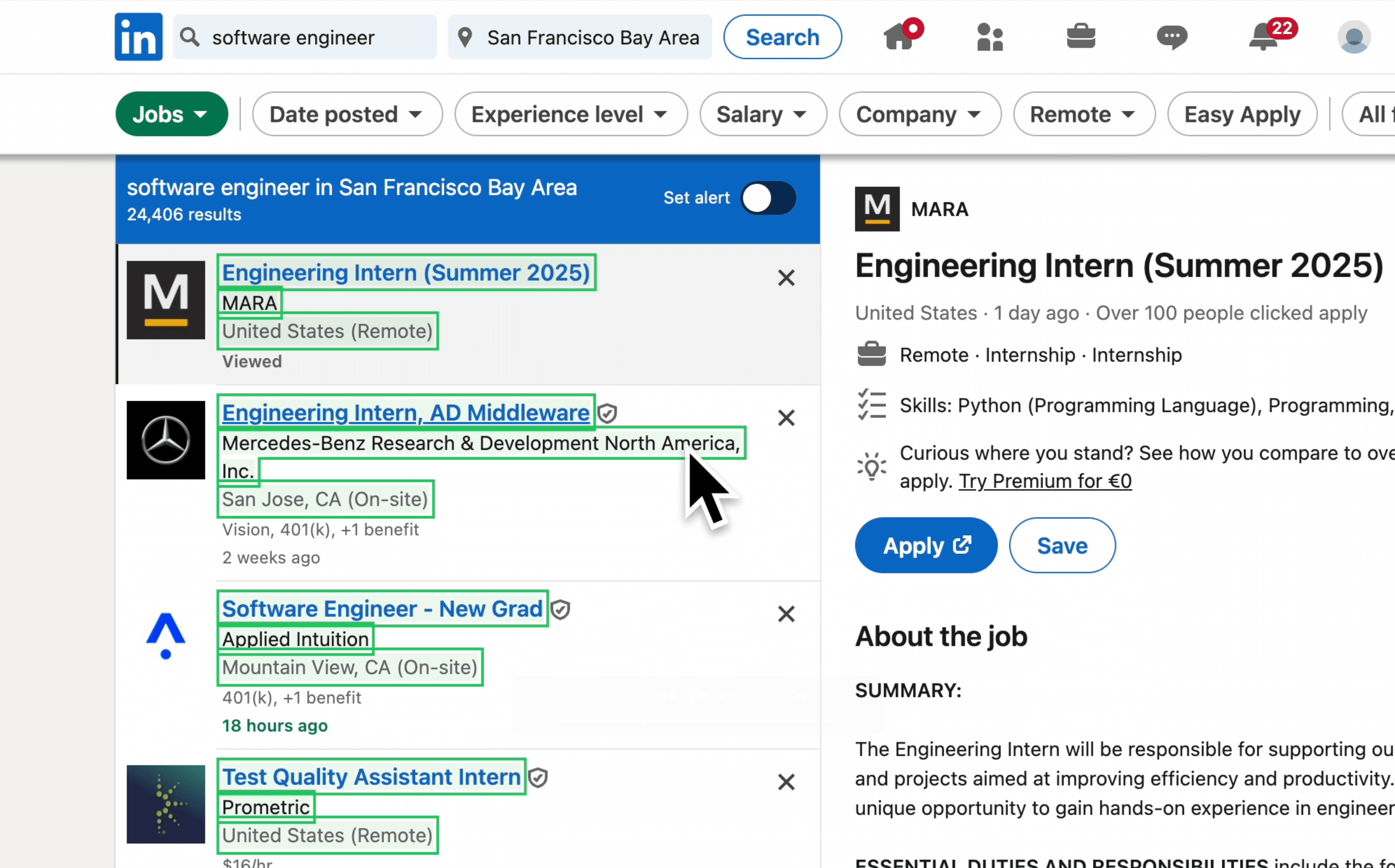Scrape LinkedIn
Learn how to responsibly extract professional data from LinkedIn profiles and company pages.

How to Scrape LinkedIn
LinkedIn is the world's largest professional network with valuable data on professionals, companies, and job listings. This tutorial will guide you through extracting public LinkedIn data responsibly and ethically for legitimate business purposes.
Important Legal Disclaimer
LinkedIn's terms of service explicitly prohibit scraping their platform. This tutorial is for educational purposes only. For production use, consider using LinkedIn's official API instead. Always ensure you have the right to access and use the data you collect, and respect LinkedIn's robots.txt file and rate limits.
Prerequisites
- Completed the intermediate Scrapify tutorials
- Scrapify Business or Enterprise account (for advanced features)
- Understanding of web scraping ethics and legal considerations
- Familiarity with LinkedIn's structure and account settings
Part 1: Understanding LinkedIn's Structure
Before we begin, it's important to understand the structure of LinkedIn pages:
- LinkedIn heavily uses AJAX and dynamic content loading
- Many pages require authentication to view
- LinkedIn employs various anti-scraping measures
- The site structure changes frequently
- Rate limiting is strictly enforced
Part 2: Setting Up Your Scraping Project
- In your Scrapify dashboard, create a new project named "LinkedIn Research"
- Enable JavaScript rendering with a 15-second wait time
- Set up session handling for authenticated scraping
- Configure rate limiting to maximum 1 request per 10 seconds
- Enable smart request throttling to avoid detection
Part 3: Authentication Handling
To access most LinkedIn data, you'll need to be logged in:
- In Scrapify, go to "Session Management"
- Select "Cookie-based Authentication"
- Log in to your LinkedIn account in Chrome
- Use the Scrapify extension to capture your session cookies
- Store these cookies in your project (never share these credentials)
Pro Tip
Consider creating a separate LinkedIn account specifically for scraping purposes. This helps maintain the privacy of your main account and allows you to configure specific settings for optimal data access.
Part 4: Scraping Public Company Pages
LinkedIn company pages contain valuable information about organizations:
- Navigate to a company page you want to scrape
- Use the Scrapify selector tool to identify key data points:
- Company name and logo
- Industry and company size
- Location information
- About section and description
- Number of employees on LinkedIn
- Create selectors for each data point
- Test your selectors to ensure accuracy
Part 5: Extracting Job Listings
Job listings provide insights into hiring trends and requirements:
- Navigate to LinkedIn Jobs or a company's job listings page
- Create selectors for job data points:
- Job title
- Company name
- Location
- Posted date
- Job description (may require following links)
- Required skills
- Configure pagination to handle multiple pages of job listings
- Set up "Load More" button handling for dynamic content
Common Challenge
LinkedIn often changes its class names and DOM structure to prevent scraping. Use more stable selectors like data attributes or element hierarchies rather than relying solely on class names which may change frequently.
Part 6: Collecting Profile Information
For collecting information from public LinkedIn profiles:
- Navigate to a profile page
- Create selectors for profile elements:
- Name and headline
- Current position and company
- Education history
- Skills section
- Experience timeline
- Handle "Show more" buttons to reveal complete sections
- Configure scrolling to ensure all dynamic content loads
Part 7: Implementing Ethical Scraping Practices
To scrape responsibly and avoid issues:
- Limit your request rate to avoid impacting LinkedIn's servers
- Only collect publicly available information
- Respect the privacy of LinkedIn users
- Don't distribute or sell the scraped data
- Consider LinkedIn's API for production use cases
- Implement randomized delays between requests (5-15 seconds)
Part 8: Handling Anti-Scraping Measures
LinkedIn employs several techniques to detect and block scrapers:
- Enable "Human Browsing Simulation" in Scrapify settings
- Configure random mouse movements and scrolling
- Set up user agent rotation to appear as different browsers
- Implement IP rotation if available (Enterprise plan feature)
- Configure session refresh to handle expired credentials
Part 9: Processing and Analyzing the Data
Once you've collected LinkedIn data:
- Export the data to CSV or JSON format
- Clean the data to remove HTML tags and normalize formats
- Structure the data into a database format if needed
- Analyze the data for insights (e.g., skill trends, company growth patterns)
- Visualize findings using charts or dashboards
Pro Tip
For research or recruitment purposes, focus on aggregated trends rather than individual profile data. This approach is both more ethical and often more valuable for business intelligence.
Real-World Example: Researching Company Growth
Let's consider a practical example of tracking company growth through LinkedIn data:
- Identify target companies in your industry
- Configure a scraper to collect employee count, office locations, and job openings
- Set up scheduled scraping to run monthly
- Store the data with timestamps to track changes over time
- Analyze growth patterns, hiring trends, and expansion into new locations
- Generate reports comparing your company's growth to competitors
Conclusion and Alternatives
While this tutorial has shown you how to scrape LinkedIn data, remember that LinkedIn's terms of service prohibit scraping. For production use cases, consider these alternatives:
- LinkedIn's official Marketing Developer Platform
- LinkedIn Sales Navigator with export features
- LinkedIn Recruiter platform for hiring needs
- Third-party data providers with licensed LinkedIn data
- Manual research for small-scale needs
Always prioritize legal and ethical data collection methods for your business needs.